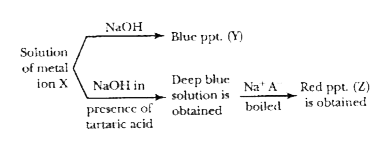The smallest size cation and anion that can exist are respectively
H+ and H−
H+ and F−
Li+andF−
Li+andH−
The correct Answer is:B
To determine the smallest size cation and anion that can exist, we can follow these steps:
Step 1: Understand the Definitions
- Cation: A positively charged ion formed when an atom loses one or more electrons.
- Anion: A negatively charged ion formed when an atom gains one or more electrons.
Step 2: Identify the Smallest Cation
- Among the cations, we can compare H⁺ (hydrogen ion) and Li⁺ (lithium ion).
- Both hydrogen and lithium are in the same group (Group 1) of the periodic table.
- As we move down a group, the size of the atoms increases due to the addition of electron shells.
- Therefore, H⁺ is smaller than Li⁺ because H has fewer electron shells.
Step 3: Identify the Smallest Anion
- For anions, we can compare F⁻ (fluoride ion) and H⁻ (hydride ion).
- The size of anions is influenced by the electron-to-proton ratio.
- For H⁻, the ratio is 2 electrons to 1 proton (2:1), while for F⁻, the ratio is 10 electrons to 9 protons (10:9).
- A higher electron-to-proton ratio typically leads to a larger size. Therefore, since H⁻ has a lower ratio than F⁻, H⁻ is smaller than F⁻.
Step 4: Conclusion
- The smallest cation is H⁺.
- The smallest anion is H⁻.
Final Answer
The smallest size cation and anion that can exist are respectively H⁺ and H⁻.
---
- Cation: A positively charged ion formed when an atom loses one or more electrons.
- Anion: A negatively charged ion formed when an atom gains one or more electrons.
- Among the cations, we can compare H⁺ (hydrogen ion) and Li⁺ (lithium ion).
- Both hydrogen and lithium are in the same group (Group 1) of the periodic table.
- As we move down a group, the size of the atoms increases due to the addition of electron shells.
- Therefore, H⁺ is smaller than Li⁺ because H has fewer electron shells.
- For anions, we can compare F⁻ (fluoride ion) and H⁻ (hydride ion).
- The size of anions is influenced by the electron-to-proton ratio.
- For H⁻, the ratio is 2 electrons to 1 proton (2:1), while for F⁻, the ratio is 10 electrons to 9 protons (10:9).
- A higher electron-to-proton ratio typically leads to a larger size. Therefore, since H⁻ has a lower ratio than F⁻, H⁻ is smaller than F⁻.
- The smallest cation is H⁺.
- The smallest anion is H⁻.
The smallest size cation and anion that can exist are respectively H⁺ and H⁻.
Similar Questions
The functional groups that are responsible for the ion-exchange property of cation and anion exchange resins, respectively, are:
View SolutionPredict the structure of MgO crystal and the co-ordination number of the cation in which the radii of the cation and anion are 65 pm and 140 pm respectively.
View Solution
Knowledge Check
- Question 1 - Select One
SbF5 react with XeF4 to form an adduct. The shapes of cation and anion in the adduct are respectively:
ASquare planar, trigonal bipyramidalBT-shaped, octahedralCSquare pyramidal, octahedralDSquare planar, octahedral - Question 2 - Select One
The smallest cation and the smallest anion are respectively
AH+ and H−BH+ and F−CLi+ and H−DLi+ and F− - Question 3 - Select One
The smallest cation and the smallest anion are respectively
AH+andH−BH+andF−CLi+andH−DLi+andF−

The cation X and the anion A are respectivelyView SolutionIn sphalerite structure C.N. of cation and anion are respectively
View SolutionThe co-ordination number of cations and anion in CaF2 and CsCl are respectively:
View SolutionCation and anions are formed in
View SolutionIn the calcium fluoride structure, the coodination number of the cation and the anion are, respectively,
View Solution

